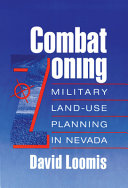
Combat Zoming
By - David Loomis
Floor
-
Floor 1
Published
-
University of Nevada Press, Reno, Nev., ©1993
ISBN 10 - 0874171873
ISBN 13 - 9780874171877
Book Status
-
1 Qnty Available with us.
Subject
-
Military bases
Shelf No
-
19
Call Number
-
355.7097 LOO
Physical Description
-
xii, 144 pages
Notes
-
Includes index